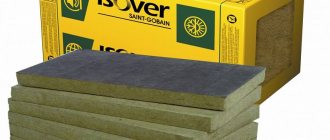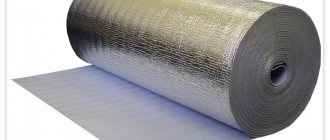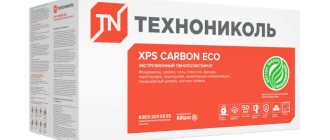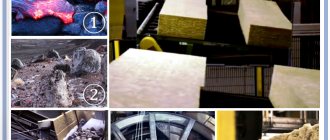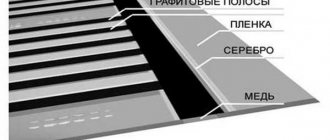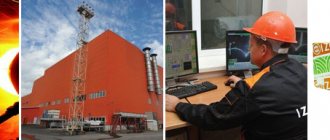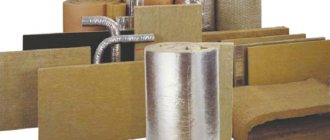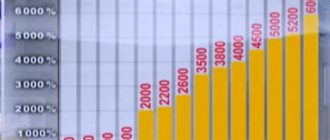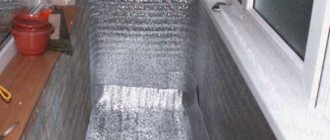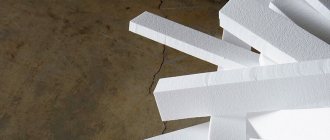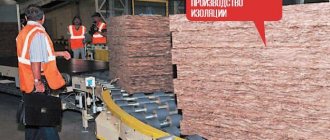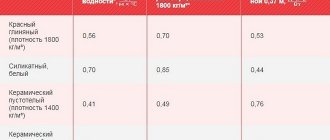Application
Its use in construction also depends on the density of mineral wool:
- For horizontal surfaces of rooms, a density of 35 kg/m³ is better.
- For interior partitions, ceilings and internal floors, mineral wool with a parameter of 75 kg/m³ is used.
- For exterior finishing of the house - 125 kg/m³.
- When thermally insulating interfloor floors, I use mineral wool with a density of 150 kg/m³, and for load-bearing structures - 175 kg/m³.
- Insulation with a density of up to 200 kg/m³ is used under a concrete screed, for a foundation or roof.
Scope and properties
Isover thermal insulation can be purchased in rolls and in slabs. This is a non-flammable material with excellent properties. The company is not a monopolist in its segment. It competes with mineral insulation materials Ursa, Rockwool, Izovol, Knauf and Parok.
The company's material is perfect for insulating and soundproofing your home
Izover mineral wool is widely used for the following types of work:
- Sound insulation and insulation of wall structures and roofs.
- Arrangement of ventilated facades and multilayer partitions.
- Installation of pipelines and other communications.
- The industry uses one of the varieties of the brand - Isotec.
Is the density of thermal insulation materials important:
Main indicators:
- Thermal conductivity is 0.041 W×m−1×K−1, which allows you to retain air without changing properties in different climatic zones.
- Maximum sound protection is achieved due to the porous structure of the material.
- Average density - 13 kg/m³. Depending on the type of insulation, it may vary slightly in one direction or another.
- Fire safety is explained by the low previous indicator, which guarantees the absolute non-flammability of the product. Therefore, the use of Izover is permitted in commercial and residential premises, cottages and apartments in high-rise buildings. Foil plates are low flammable. The main condition will be full compliance with fire safety standards when laying the material and operating the structure.
Main indicators of Izover mineral wool:
- The problem with modern insulation is the formation of condensation inside the layers. Fiberglass solutions have special water-repellent components. They help remove moisture and increase vapor permeability. For Izover it is 0.5-0.55 mg/mPa. When installing, it is recommended to leave a two-centimeter gap from the wall.
- Depending on the type and conditions of use, mineral wool from Saint-Gobain can last from 50 to 100 years.
- The absence of harmful emissions during operation guarantees the environmental purity of the insulation.
- Low weight, the lowest in its segment, allows this building material to be used even in weak load-bearing structures.
- The dimensions of the slabs and rolls allow the use of insulation with maximum rationality.
Advantages of Izover material:
Advantages and disadvantages
If we take into account all the properties of Izover thermal protection, we can derive several positive qualities when using it:
Excellent thermal insulation.
- Tolerance of extreme temperatures.
- Fire safety.
- Resistance to mechanical stress and chemical influences.
- Immunity to deformation.
- Ease of peeling.
- Tensile strength.
- Waterproof.
- High level of noise absorption.
- The material is not subject to destruction by rodents and other animals.
- Simple installation technique.
Pros and cons of isover insulation:
When working with Isover products, you must adhere to the following precautions:
- Restrict access to the construction site during work.
- Use film, plywood or gypsum fiber board as fencing.
- Use personal protective equipment: overalls, goggles, respirators.
Preparation method
In order to achieve the required qualities, all required technological standards and processes must be observed during production. Make Izover this way:
- A mixture of quartz sand, soda ash, limestone, glass waste and other minerals is prepared.
- This composition melts at a temperature of about 1300 degrees. The result is a homogeneous plastic mass.
- Next, it is fed into a bowl rotating at high speed with small holes in the walls. Through them it is squeezed out by long thin threads under the influence of centrifugal force.
- Mixed with polymer yellow glue, a sticky substance is obtained, which enters the oven for rolling and drying.
- The set layers are cut into the required formats with a circular saw.
Production of Izover insulation:
What is isover
Isover is a material that is used to insulate flat surfaces. It is produced by French. The name of the insulation comes from two French words “isolation” - insulation and “verre” - glass. It explains what it is made of. There are two forms of French insulation on the domestic market. There are slabs and rolls. They are formed using fiberglass and basalt wool. Each variety has its own technical characteristics. They determine the scope of use.
The basis of the material is fiberglass and basalt wool. When making slabs or rolls, recycled soda, limestone and sand are added. The use of recycled materials allows us to reduce the cost of the finished product, so French insulation has a very affordable price.
Insulation in the form of plates Source obustroeno.com
The manufacturing technology of isover is extremely simple:
- The listed components of recyclable materials are mixed together, other minerals are added , the mixture is heated to 1300C and converted into a plastic mass similar to liquid glass .
- It is poured into the reservoir . microscopic holes in its walls .
- The container spins like a drum and rotates at high speed . Centrifugal force forces the loaded substance through microscopic holes. In this way, the finest threads are formed .
- The threads are mixed with a special adhesive composition . A viscous mass is formed.
- She goes into the drying oven .
- There the workpiece passes through the rollers . With their help, a layer is formed .
- At the final stage, it is cut into the required sizes . The maximum possible dimensions are 610x1170 mm, the thickness of the slab can vary from 5 to 10 cm.
Density of mineral wool thermal insulation
The density of mineral wool insulation largely determines its intended purpose and is one of its main performance characteristics. Its value is influenced by the thickness and number of fibers in the structure (the percentage of foreign impurities is usually not taken into account), as a result, the higher it is, the more expensive the building material is. The insulation is produced in the form of soft mats and hard slabs with a density from 11 to 400 kg/m3; the choice of a specific brand depends on the degree of load of the structures and the construction budget.
- What parameters is density related to?
- How to choose insulation for various structures?
- Price of different brands
What does density affect?
For any insulation, the rule is true: the lighter it is, the better, but this cannot definitely be said about mineral wool. Its low thermal conductivity is indeed due to the presence of air between the threads, but when a certain minimum is reached, it ceases to retain heat. In practice, the density of mineral and basalt wool affects its weight and cost, and is also directly or indirectly related to other characteristics: thermal conductivity, noise absorption, load-bearing capacity and ease of installation.
1. Thermal insulation.
This insulation uses the properties of weightless air with a thermal conductivity coefficient of no higher than 0.026 W/m·K. Thanks to the combination of fibers with different directions, manufacturers managed to achieve a similar value of 0.036 for light and soft boards, 0.032 for semi-rigid boards and 0.04-0.046 for dense and cylindrical products (which is more than good for non-flammable insulation). But when a certain mass is reached, the fibers stop retaining air and thermal conductivity deteriorates. The worst protection is observed for loose insulation with a density of up to 30 kg/m3 with a disordered fiber direction - 0.05 W/m K.
2. Noise absorption.
Materials with low air permeability are good acoustic insulators. Therefore, dense and rigid slabs absorb sound in any case (even if this is not their main purpose). But they weigh a lot and are not always suitable for internal soundproofing of rooms; for this purpose it is better to buy specialized brands: glass wool with long and thin threads or basalt with randomly twisted fibers. Rockwool, Izover and other brands have such series; their insulation density is in the range of 45-60 kg/m3.
3. Load-bearing capacity.
Regardless of the design, overly lightweight materials are not used when installing in areas subject to high loads. This is due to the risk of deformation or creasing, low compressive and bending strength. In such cases, high-density insulation materials (at least 150 kg/m3) are clearly required. If there are supporting structures (frame, joists, reliable sheathing), the use of lightweight grades is allowed and encouraged; insulating abilities come to the fore.
4. Laying nuances.
There is a clear connection between density and ease of handling of the material. Lightweight soft insulation can be placed without problems in the inter-lag space of roofing systems (non-used surfaces) when laid from above, but installing them from the ceiling is a more than complicated process. The vertical placement of rolled grades is a little easier, but due to the risk of fibers sliding down, it is better to purchase compacted wall insulation. The most convenient option is considered to be semi-rigid slabs with slightly springy edges (up to 60 kg/m3) or high-density mineral wool.
Types of thermal insulation
All materials produced under the Isover brand differ from each other in functional purpose and physical properties. Industrial and household categories of insulation are supplied separately. There are several of the most popular varieties of products from Saint-Gobain.
Types of thermal insulation Izover:
Minvata Izover KL 34
This is a mineral plate 5 or 10 centimeters thick. It is used in frame construction and does not require additional fastening with dowels. These products are characterized by high elasticity, which maximizes the scope of application.
The insulation is packaged in a bag. After opening, it instantly takes on its original appearance and is ready for installation. Another advantage of this modification is low shrinkage. Among the technical characteristics it should be noted:
- Thermal conductivity – 0.034 W/μ.
- Vapor permeability – 0.53 mg/mchPa.
- Nominal compression at 2 thousand Pa – 60%.
- Return to normal state – 98%.
Thermal insulation of walls and floors:
This material is completely non-flammable with operating temperatures from -70 to +250 degrees. If it is completely immersed in water, it will absorb moisture no more than 5% of its mass, and when wetted - no more than 1%.
Pitched roof
This modification is intended for use as roof insulation. Available in the form of mats measuring 117x61 centimeters and 5-10 cm thick. It is almost one hundred percent hydrophobic. This is its main advantage over its competitors - the ability to use it in conditions of high humidity without loss of properties.
This type of Izover product is characterized by the following indicators:
- Thermal conductivity - 0.035 W/mK.
- Steam conductivity - 0.55 mg/mchPa.
- Absorbency with partial immersion - 0.08 kg/m² in 25 hours.
- A density of 15 kg/m³ is combined with sufficient return and deformation properties.
The advantages of the material make it number 1 in the Russian markets.
Non-combustible thermal insulation for pitched roofs Izover is sold in packages with an area of 14.72 m² and a weight of 10.8 kg.
Product category KT37
This insulation is available in rolls 630 cm long, 60 cm wide and 50 or 100 millimeters thick. Double compression packaging allows for convenient and economical transportation of the material to the construction site. If the volume of insulation in the package is 0.16 cubic meters, then after opening it increases to 0.71 m³. The scope of its application is the insulation of concrete, brick, and wooden buildings from the inside. It is not prohibited to install floors and interfloor ceilings as thermal protection.
Due to the density of 15 kg/m³, it is not recommended to use KT37 in structures with high mechanical loads. Thermal conductivity of 37 W/μ is sufficient to create an effective coating even in one layer. In this, Isover competes with Rockwool Wired Mat 80 slabs. However, the roll form of the product allows you to insulate large areas much faster with the help of a non-combustible product from Saint-Gobain.
Roof insulation:
Material indexed KT40
It is classified as wall insulation. Isover KT40 is supplied in rolls and is intended for frame, brick houses and for insulating free building cavities. The roller, which is 10 cm thick, can be easily divided in half thanks to its two-layer structure. Its remaining dimensions are: 7 meters in length and 61 cm in width. Covered area - 17.8 m².
Roll insulation Izover:
Its thermal insulation properties are slightly worse than those of other Izover materials - 0.04 W/mk. However, high vapor permeability (0.5 Mg/mPa) makes it possible to effectively insulate buildings made from any raw material with its help. To improve moisture absorption, which amounts to 15% of the weight of the product, it is recommended to install additional waterproofing. GOST 30225 classifies KT40 as non-combustible thermal insulation.
Basalt mass
Russian factories, in addition to fiberglass slabs, produce materials in the form of stone wool. Similar varieties have the following differences:
- Higher cost.
- More durable, stronger and denser than traditional mineral wool.
- Less elasticity. Packages are larger, increasing the cost of storage and transportation.
- High moisture and heat resistance.
Basalt insulation is more expensive, but of the highest quality
Experts recommend laying such insulation in structures subject to mechanical stress.
Classification of basalt insulation:
- Optimal - for pitched roofs in the form of sound and thermal protection.
- Light - for frame house construction.
- Acoustic - for sound insulation.
- Floor - from impact noise.
- Ruf V, Ruf N - for flat roofing.
- Plaster and Facade-Master are designed for facades under plaster.
- Venti - with improved vapor permeability.
- The standard applies to multi-layer brickwork.
Testing basalt wool for combustion:
Table 1
| Material | Density, kg/m3 | Dry thermal conductivity coefficient λ, W/(m oC) | Calculated thermal conductivity coefficients in wet condition* | |
| λA,W/(m oC) | λB,W/(m oC) | |||
| Concrete | ||||
| Reinforced concrete | 2500 | 1,69 | 1,92 | 2,04 |
| Aerated concrete | 300 | 0,07 | 0,08 | 0,09 |
| 400 | 0,10 | 0,11 | 0,12 | |
| 500 | 0,12 | 0,14 | 0,15 | |
| 600 | 0,14 | 0,17 | 0,18 | |
| 700 | 0,17 | 0,20 | 0,21 | |
| Brickwork | ||||
| Ordinary clay on cement-sand mortar | 1800 | 0,56 | 0,70 | 0,81 |
| Silicate on cement-sand mortar | 1600 | 0,70 | 0,76 | 0,87 |
| Ceramic hollow core with a density of 1400 kg/m3 (gross) on cement-sand mortar | 1600 | 0,47 | 0,58 | 0,64 |
| Ceramic hollow core with a density of 1000 kg/m3 (gross) on cement-sand mortar | 1200 | 0,35 | 0,47 | 0,52 |
| Silicate eleven-hollow on cement-sand mortar | 1500 | 0,64 | 0,70 | 0,81 |
| Silicate fourteen-hollow on cement-sand mortar | 1400 | 0,52 | 0,64 | 0,76 |
| Tree | ||||
| Pine and spruce across the grain | 500 | 0,09 | 0,14 | 0,18 |
| Pine and spruce along the grain | 500 | 0,18 | 0,29 | 0,35 |
| Oak across the grain | 700 | 0,10 | 0,18 | 0,23 |
| Oak along the grain | 700 | 0,23 | 0,35 | 0,41 |
| Insulation | ||||
| Stone wool | 130-145 | 0,038 | 0,040 | 0,042 |
| Expanded polystyrene | 15-25 | 0,039 | 0,041 | 0,042 |
| Extruded polystyrene foam | 25-35 | 0,030 | 0,031 | 0,032 |
*λA or λB is taken into account depending on the city of construction (see table 2).
Where is Izover and its varieties used?
This material has several varieties. Each of them is designed to perform specific jobs. We list them below.
Isover KL34
Isover KL34 is available in slabs 5 or 10 centimeters thick. They are mounted tightly on the frame; there is no need to use additional fasteners. These slabs can be used to insulate a ventilated facade and masonry consisting of several layers. Any plane is suitable for insulation: vertical, horizontal, and those that are inclined.
Isover KL37
Isover KL37 is supplied in tightly compressed packaging. It also does not require additional fasteners during installation. This material is used to insulate floors between floors, walls, and roof slopes. In this case, a tight fit of the material to the surface is necessary.
Isover KT37
Isover KT37 is available in compressed rolls. It does not require fastening elements, but, like the previous material, it must adhere well to the insulated plane. It is used for thermal insulation of roofs, attics, floors between floors, walls and partitions indoors.
Isover KT40
Isover KT40 is a two-layer material (each layer is 5 centimeters thick), which is produced in the form of tight rolls. It is used without additional fasteners to insulate horizontally located surfaces - floors and ceilings. If the cavity to be filled with insulation is not deep enough, then the isover can be divided into two layers.
Isover STYROFOAM 300A
But a material such as Isover STYROFOAM 300A requires the mandatory use of fasteners. It is produced in the form of hard, rough slabs, the surface of which adheres well to concrete. The composition of this insulation includes extruded polystyrene foam, due to which insulated cells are formed.
This increases temperature resistance and moisture resistance. This heat insulator is suitable for use on both horizontal and vertical surfaces. They insulate external and internal walls, floors and flat roofs. You can apply plaster on top.
Isover VENTITERM
Isover VENTITERM is a universal insulation material. It is produced in the form of rigid slabs treated with a water repellent. The basis of this material is mineral wool, consisting of basalt fibers. They insulate (on one side) ventilated facades, as well as pipes for ventilation and water supply. It is also used to protect precision instruments from cold.
Isover pitched roof
Isover pitched roofing is an insulation material used for thermal insulation of the roof. Available in slabs 61 centimeters wide and 10 or 5 centimeters thick. It practically does not absorb moisture and also absorbs sounds well. High vapor permeability and non-flammability are two more useful properties of this material. It holds heat well, especially if you use two layers, the top of which covers the joints of the bottom
Important: during installation, the pitch of the rafter system must be such that the insulation boards do not fall through
Isover ventilated façade
Isover ventilated facade is no different from ordinary Isover. It is produced in a two-layer form, thanks to which it retains heat well. During installation, do not allow the insulation to lag behind the surface.
Isover sound protection
Isover sound protection is available in the form of mats and slabs. It is better able to protect the room from external sounds than other insulation materials. It is used to insulate suspended ceilings and internal partitions.
Characteristics of Izover insulation
This material is made from the highest quality fiberglass using TEL technology, which is patented. All this makes Isover one of the best thermal insulators, differing from its analogues for the better. Let's list its useful qualities.
Thermal conductivity
The thermal conductivity coefficient of this insulation has a tiny value - 0.041 watts per meter per Kelvin. Moreover, this value does not change upward over time (as is often the case with other heat insulators). Thus, Isover glass fibers, which retain air well, retain heat excellently.
Soundproofing
As for the ability to protect against external noise, fiberglass materials are excellent here too. This is again due to the fact that there is an air layer between the glass fibers, which successfully blocks extraneous sounds. Therefore, you will be guaranteed silence in a room insulated with Izover. For these purposes, special varieties of material have been produced.
Flammability
All thermal insulation materials with a density of up to 30 kilograms per cubic meter and called Isover are considered non-flammable. This is how they are defined by the corresponding GOST 30244-94, which assigns them the abbreviation NG. Therefore, it is quite possible to use such insulation in any home - the characteristics of Izover of this type allow this. Its use is absolutely safe for thermal insulation of both a one-story cottage and a high-rise building.
Rigid and semi-rigid materials, as well as those covered with Tyvek film, aluminum foil or fiberglass, are considered low flammable. According to GOST they are designated SG. There are restrictions on the use of such insulation, but there are very few of them. So they can be used almost anywhere. The main thing is to strictly comply with the fire safety requirements of buildings and structures set out in SNiP 01/21/97.
Vapor permeability
Now let's talk about resistance to moisture. After all, this parameter is the “weak link” of many modern heat insulators. They perform their function well only when the air in the room is dry. If it contains moisture, then even fiberglass's ability to retain heat may deteriorate. But glass fibers are good because they quickly give back all the moisture they have absorbed.
And to do this, you must remember to leave a gap of at least 2 centimeters between the wall and the insulation for ventilation. If this is not done, the thermal insulation qualities of this material will begin to decrease as it absorbs moisture. Unfortunately, this is a drawback of all such materials. The vapor permeability of Izover is in the range of 0.50 - 0.55 mg/mchPa. When the insulation is moistened by 1%, the thermal insulation sharply deteriorates by up to 10%.
Life time
The most important parameter is the service life of the insulation. Even if it stores heat perfectly, but can last a year at most, it’s unlikely that anyone will like it. Insulating a house is a painstaking task, and doing it every year is not a pleasant task. But, fortunately, these claims do not apply to Izover. Having laid walls, floors or ceilings with this material, you can forget about insulation for many years. There are examples of using this insulation for more than 50 years without loss of thermal insulation qualities.
Isover also contains water repellents that have water-repellent properties. In addition, bugs and other insects do not settle in this insulation - they do not like such a habitat. Fiberglass insulation is also not suitable for mold.
Environmentally friendly and harmless
Fiberglass materials of this type are absolutely harmless to human health and life. During their operation, no harmful substances are released. Finnish scientists have been checking this fact for half a century. No danger was detected - this verdict was repeatedly made by specialists from the Institute of Cancer Problems.
Insulation weight
If we compare Izover with other heat insulators in terms of weight, it will turn out to be much lighter than the others. Therefore, in those buildings whose walls are made of not very strong materials or where excessive load is unacceptable, the use of Izover will be an excellent way out of the situation.
Release form
For the convenience of consumers, this insulation is produced in various forms. These are rolls, slabs of varying hardness, mats. The thickness of single-layer Isover varies from 5 to 10 centimeters, and for double-layer Izover the thickness of each layer is 5 centimeters. Slabs are usually made no larger than meter by meter, but sometimes there are exceptions.
Izover packaging in the form of compressed slabs.
The area of one roll is from 16 to 20 square meters. The standard roll width is 1.2 meters, and its length is from 7 to 14 meters.
Izover in compressed rolls, when removing the packaging shell, straightens on its own.
Other characteristics
- Density is about 13 kg/m3.
- The density of the connection to the base is not very good and may decrease depending on the object being insulated.
- Air permeability is 120*10-6m3/m×s×Pa.
In general, many characteristics will depend on the type of material and its purpose; all characteristics can be viewed in more detail on the official website of the Isover company.
Peculiarities
Izover insulation has some features:
- The material has good thermal conductivity. If we consider the Isover product line, then the warmest one based on quartz is Isover “Warm Walls”, and among basalt insulation products – Isover “Master of Warm Walls”.
- Soundproofing qualities. The dense weave of fibers prevents noise vibrations from penetrating through the thickness of mineral wool. The main obstacle to the penetration of sound is the air that fills the voids between the fibers.
- Any Isover model is considered completely non-flammable. This feature allows the use of this thermal layer in rooms of any type.
- Vapor permeability. This quality of mineral wool is at a low level. In rooms with high humidity, Isover insulation quickly becomes saturated with moisture, losing some of its thermal insulation qualities. To provide protection to the product, a vapor barrier is initially laid, after which the installation of mineral wool is allowed. The gap between the front trim and the outer layer of insulation provides additional protection.
- Durable. Having installed Izover insulation once, you can forget about re-installation for 50 years or more. The material owes this feature to its structure.
- Environmentally friendly. Scientists have repeatedly conducted studies to identify side effects on human health from insulation, but so far no such effects have been found.
Installation of thermal protection
A wide range of uses implies several options for working with Izover materials. There are 4 technological options in total:
- Metal frame structure.
- Wooden building.
- Using staples.
- On the plinth.
When installing thermal protection, seek help from a specialist
When assembling a thermal insulation complex, the physical properties of the materials should be taken into account. It is worth providing additional protection from moisture using special films. When laying a roofing or wall pie, a certain order of layers should be observed. The vapor barrier is usually pulled from the inside to prevent the formation of condensation. The waterproofing is installed outside to protect against precipitation.
It is very difficult to choose the best of the many varieties of Izover products. Each type has its pros and cons. However, due to the diversity of the assortment and the optimal price-quality ratio, this product is recognized as the most popular.
All about insulation and thermal insulation Izover:
Throughout the entire existence of man on Earth, people have always strived to improve their living conditions. One of the primary tasks was to ensure that housing met all needs. Creating a warm and cozy “nest” became possible with the advent of modern building materials.
In the 20th century, glass wool was often used to insulate houses. This material has proven itself well and it was on its basis, with the help of the latest developments, that a completely new product was created that shook the construction products market - Isover insulation, competitors KNAUF, TechnoNIKOL.
Thermal insulation materials Izover are also made on the basis of stone fibers, and are better known as basalt insulation.
Technical characteristics, properties and a wide range of applications allow Izover thermal insulation materials to occupy a leading position among world analogues. The choice in favor of the products of this manufacturer is evidenced by numerous positive customer reviews. According to statistics, during the construction of every third European house, Izover products were used, for example, for insulating walls, floors or ceilings.
Using wool of different densities for insulation
The choice of insulation according to the indicator under consideration depends on the place of its use. It is not always necessary to overpay in order to get the desired result. Most often, the facade, walls, roof and floor are insulated. These are the options that are worth considering.
Facade
When selecting insulation for a facade, you need to pay attention to the mass and density of mineral wool. For most buildings, weighting is very undesirable. It is also worth paying attention to the possibility of subsequent finishing, because this indicator is also influenced by
So:
It is also worth paying attention to the possibility of subsequent finishing, because this indicator also affects this. So:
- If the facade is equipped with a ventilated one, then a sufficient density is 45-100 kg m³. Here the cotton wool is laid into the sheathing and there will be virtually no stress. The main tasks for this type are to maintain its shape and not sag under its own weight, and the indicated indicator is enough for this.
- If the facade is to be plastered over insulation, then the density should be above 100 kg m³, optimally from 145 to 165. This will allow the use of any types of plaster mixtures, including bark beetle, barenkom and even mosaics. Since this mineral wool will have to withstand heavy loads during installation, it must be securely fastened; for this, a system with dowels is used in combination with adhesive fastening.
Wall insulation
In this case, the selection is made based on ease of installation, that is, the density should be at least 30-45 kg m³. In this case, you need to insulate from the inside; MDF boards or drywall should be screwed onto the material on top. In order to mount such mineral wool, you need a lathing; rolls or sheets are placed in it.
Roof
Since roof insulation work is carried out at heights, the main criteria when selecting mineral wool are light weight and ease of use. Material with a density of 30-35 kg m³ can be pleased with these qualities. Its sound and heat insulation properties will be excellent, and at the same time light weight. Installation can be carried out using two methods:
- Using a construction stapler.
- In the lathing with a vapor barrier closure.
In both the first and second cases, it is necessary to cover the insulation with finishing material on top.
The selection of mineral wool in this case depends on the type of floor finishing. So, if these are sheet materials, for example solid boards, laminate, etc., then a density of more than 30-45 kg m³ is not needed. After all, there will be no pressure on the cotton wool; it is placed between the lags.
But now manufacturers offer material with an indicator of 200-220 kg m³; such wool can be mounted on the base and filled with cement screed on top. Of course, the price of such material is quite high, but the ease of handling is the greatest possible.
Izover - storage rules
If you have to store it for some time before making Izover insulation, be sure to follow the following rules:
- it is better to lay the material on pallets to prevent moisture absorption and mechanical deformation of the slabs;
- When laying slab material in layers, place heavier packages down to prevent them from creasing and changing shape;
- make sure that the packaging remains sealed;
- Open the bags carefully during installation so that they can later be used as packaging for collecting construction waste.
Isover glass wool: types and technical characteristics
Izover is produced in rolls, mats and slabs, which differ in their dimensions.
Glass wool is made from residues from the glass industry, or less commonly from the basic raw materials used to produce glass. There are some restrictions that narrow the scope of use of Izover glass wool insulation. The technical characteristics of the material exclude operation in a damp environment without additional protection. This insulation absorbs moisture very strongly and dries poorly. Moreover, when the material gets wet, it ceases to perform the functions of thermal insulation. Therefore, you need to use special films that prevent moisture from penetrating into the Izover insulation. Reviews clearly confirm the failure of the material without steam and waterproofing.
Glass wool is available in:
- rolls;
- matah;
- slabs
What's the difference between them? Rolls are soft rectangular pieces of insulation, which differ from mats in their length (they are longer). Mats are also wrapped in rolls, but they are shorter and somewhat denser. Usually two mats are wound in one roll. The slabs are denser, they do not roll into rolls and are sold in rectangular packages. Various materials are used for interior and exterior work. Izover mineral wool insulation - characteristics common to all positions:
- thermal conductivity coefficient – ranging from 0.037 to 0.044 W/m*C;
- flammability group - NG, that is, does not burn;
- moisture absorption is high.
Let's take a closer look at Isover insulation. The technical characteristics of each type differ quite a bit, mainly dimensions and density.
Mats
Pro - used indoors and outdoors, a universal material that is popular. Thickness 50, 100 and 150 mm. Classic – thickness 50 mm, 2 mats wound in a roll. It is used for insulation of floors, roofs along joists, and ceilings along lathing. M37 frame - thickness options 40, 50, 60, 100 and 150 mm. It is used to fill the space between walls when insulating frame houses. Frame M34 – thickness 50 mm, less dense than M37. Frame M40AL – foil insulation with a thickness of 50, 100 and 150 mm.
Plates
Isover mineral wool can be with foil, which protects it from moisture.
Mineral wool Isover Classic Plate – thickness 50 and 100 mm, used for insulating vertical structures indoors and outdoors. Pitched Roofing – used for thermal insulation of a pitched roof and attic between the joists; it is installed without additional fixation.
Sound protection - available in thicknesses of 50, 70, 75 and 100 mm, laid on horizontal and vertical surfaces indoors. Frame P32 – wide choice of thickness (50, 60, 65 and 100 mm), width 610 mm. It is used for laying in the cavities of the walls of frame houses. Frame P37 – possible thickness options: 50, 100 and 150 mm. Two width options – 565 and 610 mm.
Plaster facade – used for external insulation of walls using wet facade technology. Ventilated facade (top) – only 30 mm thick, used as the top layer for two-layer insulation of walls from the outside using ventilated facade technology. Ventilated facade (bottom) – thickness 50 and 100 mm, used as the bottom layer of insulation in two-layer ventilated facades. Ventilated facade Optima - has the lowest thermal conductivity coefficient, which is 0.032 W/m*C. OL-P – fits under the screed. OL-PE and OL-TOP - for insulating flat roofs as the bottom and top layers, respectively.
Scope of application of fiberglass products
“Isover” is considered a universal insulation material, therefore it is suitable for the following work:
- Heat and sound insulation of external wall structures.
- Roof insulation.
- Arrangement of ventilated facades.
- Soundproofing of internal wall partitions.
- Industrial ventilation systems, pipelines.
| The product's name | We recommend using it together with | |||||
| Classic | Classic Stove | Pro | Sauna | vapor barrier | hydro-moisture barrier | |
| Insulation of pitched roofs | fits | fits | we recommend | — | Yes | Yes |
| Insulation of external walls under cladding or brick | fits | we recommend | we recommend | — | Yes | |
| Insulation of walls from the inside | fits | we recommend | we recommend | — | Yes | |
| Insulation of frame walls | fits | we recommend | we recommend | — | Yes | Yes |
| Soundproofing of partitions | fits | we recommend | we recommend | — | ||
| Insulation of attic floors | fits | fits | we recommend | — | Yes | |
| Insulating the ceiling above the basement | fits | fits | we recommend | — | Yes | |
| Soundproofing floors using joists | fits | fits | we recommend | — | ||
| Soundproofing of suspended ceilings | fits | fits | — | — | ||
| Insulation + vapor barrier of internal walls and ceilings | — | — | — | Yes | ||
Scope of application and characteristics of thermal insulation materials Izover
Insulation of a frame house
A qualitative reduction in heat loss involves insulating all enclosing structures of a building or part of it, including internal, external, horizontal, inclined and vertical surfaces. The capabilities of this insulation are not limited to any one direction.
In addition to its main function, this material does a good job of soundproofing and insulating the pipeline. Izover mineral wool is optimal for thermal insulation of wooden, frame, monolithic or block houses. Resistance to open flame and high temperature determines its use even in bathhouses or boiler rooms.
Roll insulation
Isover roll insulation has unique technical characteristics:
- thermal conductivity coefficient – 0.040;
- non-flammable, environmentally friendly;
- the basis of the composition is quartz threads;
- the length of a roll consisting of two mats is 10-11 m;
- width (standard) – 120 cm;
- mat thickness – 50 mm.
Isover is resistant to fire
Advantages of “stone” wool:
- fire resistance;
- resistance to temperature changes;
- low conductivity of heat and sound;
- simplicity, speed of installation;
- elasticity;
- availability.
Flaws:
- lack of resistance to moisture;
- spread of glass dust;
- lack of rigidity.
Advantages of Izover
Taking into account all the technical characteristics of Izover mineral wool described above, we can conclude that it has the following advantages:
- excellent level of thermal insulation;
- resistance to any, even extreme temperature conditions;
- fire safety;
- resistance to mechanical and chemical stress;
- easy delamination and no deformation during compression;
- tensile strength;
- moisture resistance;
- excellent noise absorption;
- absolute resistance to any biological influence, in particular to rodents;
- ease of installation.
Isover (Egoryevsk, Chelyabinsk)
More than 20 years ago, the French concern Saint Gobain officially opened the Russian building materials market. Over the past 10 years, the company's management has abandoned the import of mineral wool to Russia and opened its own production of products under the Isover brand in the Moscow region. Today, there are two full-cycle production sites in the Russian Federation - in Yegoryevsk and Chelyabinsk.
Isover mineral wool is suitable for ventilated facades and under plaster; for pitched and flat roofs; into internal partitions and doors. The materials are developed in accordance with the operational features and installation specifics for each specified case. The company's catalog presents four main groups:
- Isover warm – thermal insulation;
- Isover quiet - Shumka;
- Isover professional – universal insulation;
- Isover for a house/apartment - mineral wool with a compromise combination of cost and performance.
The list offers 24 insulating material options.
All plate, roll and blown-in wool versions are packaged in heat-shrinkable polyethylene. This makes it possible to reduce the volume of insulation ready for shipment by 3-5 times (relevant for more efficient transportation).
The positive aspects of Isover are the variety of options. Can be made to your size. Among the existing advantages, the ease of use when filling hard-to-reach areas with blow-in cotton wool stands out.
The downside is the need to use highly specialized equipment (true only for the blown-in version of mineral wool).
Main characteristics of Isover
| Isover Warm Roof | Isover Blown Wool | Isover Soundproofing | |
| Purpose | Insulation of roofing systems | Thermal insulation of hard-to-reach places | Soundproofing of premises |
| Dimensions, mm | 5 000х1 220х50 | 1 000х440х400 | 1 170x610x50 |
| Density, kg/m³ | 16 | 30-50 | 14 |
| Thermal conductivity, W/(m K) | 0.037 | 0.032-0.038 | 0.038 |
| Quantity per package(pieces/m²/m³) | 2 / 12 / 0.61 | — / — / 0.176 | 14 / 10 / 0.5 |
| Price, rub/m³ | 1 178 | 1 200 | 1 617 |
Video instructions from Isover on weaving structures:
https://youtube.com/watch?v=TMLhlO86hf0
Application of Izover, its specifics and varieties
It is known that approximately forty percent of heat loss occurs through the wall partitions of a building, so insulating “weak spots” with high-quality material, subject to and following all installation rules, is a guarantee of heat preservation in the house. As a result, spending on more expensive and reliable insulation will provide further savings on heating all rooms during the cold season.
The manufacturing company invites customers to choose the most suitable insulation among several types, which can be divided depending on the area of application.
Areas of application of Izover thermal insulation:
- roofs and ceilings;
- external walls;
- internal, interior partitions.
Further types of Izover products...
Izover KL-34
This type of Izover product consists of slabs, the thickness of which can be 5 or 10 centimeters. It is suitable for insulating any planes - vertical, horizontal, inclined. Due to the tight fit on the frame, the use of additional fasteners is not required. KL-34 slabs are often used to insulate ventilated facades.
Izover KL-37
A soft fiberglass based insulation that is designed to work in buildings where the insulation is not heavily stressed. Interestingly, the packaged material is subjected to additional compression by 2 times - this helps reduce the overall volume, thereby slightly reducing delivery costs. Like the previous type of Izover insulation, KL-37 does not require additional fasteners. However, it should be remembered that during installation it is necessary to comply with the condition - to strive for the tightest possible fit of the slabs to the surface.
Izover KT-37
It is used for insulation of attics, roofs, as well as interfloor ceilings. The main difference from KL-37 is that it is a roll material. The remaining characteristics, recommendations for operation and installation are the same.
Izover KT-40
It is supplied in rolls and, unlike other Izover products, this type of material consists of two layers, each of which is 5 centimeters thick. KT-40 will be an ideal option if installation is carried out in a wooden or metal frame, where the distance between the posts is 60 centimeters.
Isover STYROFOAM 300A
Produced in the form of slabs with extruded polystyrene foam. This material requires the use of fasteners. Thanks to the special composition of STYROFOAM 300A boards, the heat and moisture protection indicators are higher than those of many similar products. This type of Izover insulation has found its application in the thermal insulation of walls, floors and flat roofs. It is allowed to apply a layer of plaster directly on top of the slabs.
Isover VENTITERM
Insulation based on mineral wool with basalt fibers. The versatility of this material is due to the fact that installation can be carried out both with and without fasteners. Professionals have long found use for this insulation in insulating water supply systems and ventilation pipes.
Izover Pitched roof
Izover Pitched Roofing has been specially developed to protect the roof. This type of insulation not only allows you to retain heat, but also, thanks to its ability to absorb sounds from the outside, creates an atmosphere of peace and quiet. Positive properties also include the non-flammability of the material and good vapor permeability. It must be remembered that the pitch of the rafter system must correspond to the dimensions of the insulation boards.
Izover Soundproofing
Izover Sound Protection mats and slabs are designed specifically to minimize the possibility of penetration of extraneous noise from the outside. Installation can be carried out in internal partitions or suspended ceilings.
Isover Sauna
Insulation Izover Sauna. In addition to the fact that this material has all the qualities of high-quality insulation, Izover Sauna also creates a barrier to steam, making it ideal for installation in baths, saunas and rooms with high humidity. The material is mats with a thickness of 5 or 10 centimeters and is supplied in rolls.
To make it easier to search and select the right product, the manufacturer of thermal insulation materials Izover has developed and presented a line of products indicating the purpose and area of application right in the title:
- Izover Warm home.
- Izover Warm roof.
- Izover Warm walls.
- Izover Quiet House.
Thickness of Izover wool
If you cannot decide on the thickness of mineral wool, pay attention to Izover products. It is offered for sale in several varieties, which are classified into slabs and mats
For example, for thermal insulation of frame structures, you can use “Kakas-P32”, P34, P37 P40, P40-AL, “Sound Protection” and “Floating Floor”, as well as “Pitched Roof”.
As for the P32 slab, it is represented by a material whose thickness varies from 40 to 150 mm. P34, P37 have a more impressive thickness. Plates of this material are limited to parameters from 40 to 200 mm. But mats P40, P40-AL have a smaller thickness variation - 50-200 mm. To soundproof ceilings, partitions and walls from the inside, you can use Izover Sound Protection; its thickness remains the same as in the above-mentioned case.
For a floating floor, slabs are used, their thickness is equal to the limit from 20 to 50 mm. For pitched roofs, you can purchase insulation whose thickness is 50 and 200 mm. The thickness of OL-E mineral wool, which is used to insulate walls under plaster, is in the range from 50 to 170 mm. The slabs that are used to construct a plaster facade can have a thickness from 50 to 200 mm.
In general, Izover is a fairly common brand of thermal insulation materials. These insulation materials have excellent characteristics, among them the following should be highlighted:
- high level of sound insulation;
- low thermal conductivity;
- environmental safety.
As for the thickness, it can vary depending on the purpose and type.
Application of mineral wool
As mentioned above, mineral wool has a wide range of applications. Depending on what kind of surface will be insulated and how much you are willing to spend on the construction process, choose the appropriate installation technology from the 4 existing ones:
- On a metal frame.
- On a wooden frame.
- On the staples.
- On the base profile.
Important! In order not to exceed your own estimate, take into account the manufacturer’s recommendations regarding the appropriate method of attaching Izover mineral wool. If you choose the right material option, you will definitely not have any difficulties with installation, even if you decide not to involve specialists, but to do all the work yourself.
